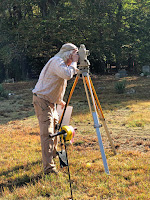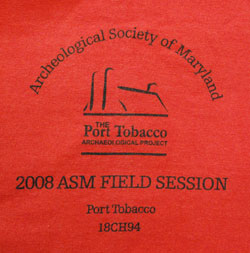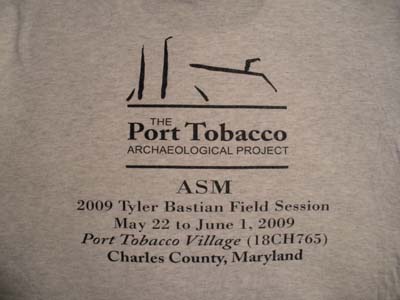CCASM has been working with Charles County at the ongoing Public
Archaeology Lab for a number of years. The lab is for processing artifacts recovered
from various archaeology initiatives in Charles County - including processing artifacts recovered from savage archaeology in the County as
well as those recovered in the 1970's around the Port Tobacco Courthouse. Esther Read is the archaeologist in charge.
Health precautions: Following guidelines for Charles County Phase 3 reopening.
Masks required. Social distancing maintained. Temperature taken before allowed to participate. (Wipes, hand sanitizers, ... provided by County.)
Location: Courthouse and Burch House (both inside and outside) in Historic Port Tobacco Village map
Next dates:
Currently no public labs scheduled but independent work on projects can continue.
 At the November 16 Lab Elsie and Mary worked on paperwork while Denise and Linda washed and sorted artifacts.
At the November 16 Lab Elsie and Mary worked on paperwork while Denise and Linda washed and sorted artifacts.  They choose this interesting English Brown Stoneware rim that had been stamped with "WR" as the artifact of the day. An English Act passed in 1700 during the reign of William III required vessels used for the sale of beer or ale to be stamped with an impressed "WR" mark to designate the vessel conformed to standard capacities--either a pint or a quart.
They choose this interesting English Brown Stoneware rim that had been stamped with "WR" as the artifact of the day. An English Act passed in 1700 during the reign of William III required vessels used for the sale of beer or ale to be stamped with an impressed "WR" mark to designate the vessel conformed to standard capacities--either a pint or a quart.For the artifact of the day we decided it was time for something that was not ceramic or glass and choose this nice gun flint.
As an aside, the field notes from the work done in Area B Feature 1 (BF1) were found in a cardboard box off site. (It's amazing what you find when you have to stay home and decide to clean out storage areas.) Now we know the location of the different units within this feature as well as information on the levels within each unit.
Even though it didn't rain, the October 19 day in the field at Rich Hill had to be cancelled due to a cat and a broken little toe.
October 5 was a beautiful day to be outside. Mary, Denise, Julie, and Elsie took advantage of that on their first day of actually working in the lab. They washed artifacts on the picnic tables behind Burch House. Among the artifacts washed was this 17th century Staffordshire slipware rim sherd with a scalloped edge. It was found in BF1-2-6 along with other sherds including three 18th century "Tortoiseshell" Whieldon ware sherds and three Buckley sherds.
Thanks to Elsie for the photo and the information.
September 28 Linda, Mary, Denise, Carol, and Esther continued getting ready to start up lab. Additional deteriorating bags of artifacts were brought down from the Port Tobacco Courthouse attic. The artifacts were put into more substantial bags and taken to Burch House where they will be washed. We determined where we left off with the cataloging and set up two socially distanced workstations to continue cataloging artifacts on the second floor of the Courthouse. We are now ready to start.
 September 21 Linda, Elsie, Mary, Julie, and Carol met with Esther in Port Tobacco Village to get ready to start lab again. With our masks on we divided into two groups to attack moving and cleaning chores.
September 21 Linda, Elsie, Mary, Julie, and Carol met with Esther in Port Tobacco Village to get ready to start lab again. With our masks on we divided into two groups to attack moving and cleaning chores. Working with SRPT Charles County had addressed the mold problem in Burch House. Also SRPT had had the interior re-plastered and painted. In the process things in the archaeology lab had been moved. These items were moved back. Also the archaeology boxes in the attic were counted. The mold could not be completely removed from the cardboard boxes, and the boxes will have to be replaced.
Also in order for there to be more room to social distance in Burch House, equipment used when in the field, e.g. shovels, toolbox, buckets, needed to be removed from Burch House. The designated shed near Stagg Hall was cleaned out to provide a place for archaeological equipment.
2020 Public Archaeology Lab Days (Jan-Mar)
2019 Public Archaeology Lab Days (Jul-Dec)
2019 Public Archaeology Lab Days (Jan-June)
2018 Public Archaeology Lab Days (July-Dec)
2018 Public Archaeology Lab Days (Jan-June)
2017 Public Archaeology Lab Days (July-Dec)
2017 Public Archaeology Lab Days (Jan-June)
2016 Public Archaeology Lab Days (July-Dec)
2016 Public Archaeology Lab Days (Jan-June)
2015 Public Archaeology Lab Days



















































